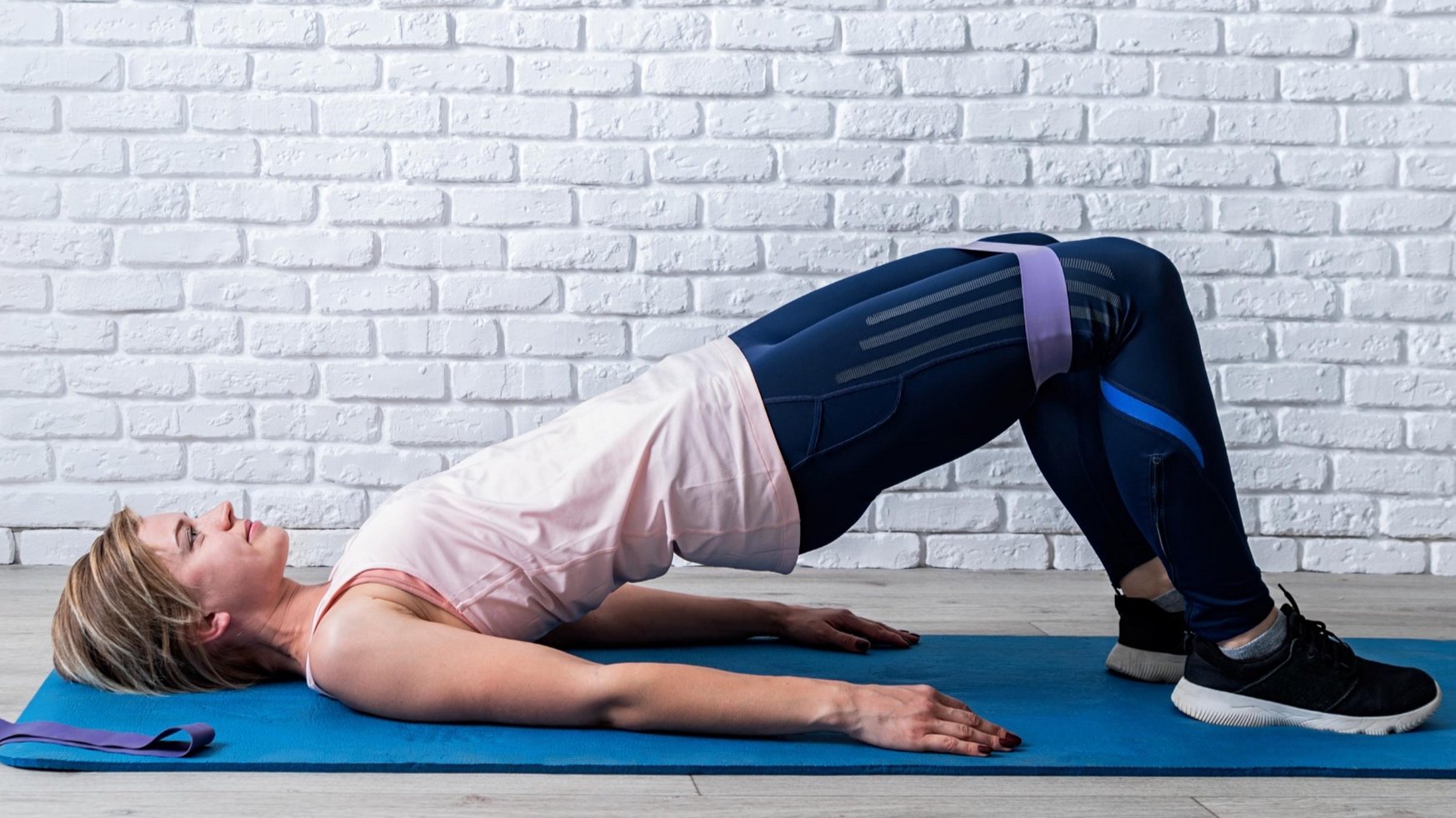5 Reasons to hip thrust
5 Reasons to Hip Thrust
The hip thrust Is increasingly acknowledged as one of the most powerful exercises to be included in our workout. This is because, so many of us work in sedentary roles. The prime purpose of the hip thrust is to strengthen the glutes, or gluteal muscles. The glutes are made up of 3 muscles:
The glutes consist of 3 major muscles:
The gluteus maximus, which does external rotation and extension of the hip joint (moving the leg backwards).
The gluteus minimus, which does abduction of the hip (moving the leg away from the centre of the body).
The gluteus medius, which also does abduction of the hip (moving the leg away from the middle line of the body).
As you can see these muscles are important movers and stabilizers of the hip joint. The glutes assist us in walking, sitting, standing, climbing stairs, getting out of bed, and every other lower body movement. In an exercise setting these muscles are particularly used when squatting, dead lifting and performing lunges.
The problem these days, is that we sit on the glutes all day long, rendering them inactive and sometimes weak. Without the proper use of the glutes, and hamstrings our lower back muscles can end up taking over far more work than they should. The abdominals are strong and can support a weak lower back, but if the lower back keeps having to compensate for sleepy glutes injury and pain will become a problem.
Here are just some of the benefits of training the glutes through the hip thrust movement and bridge:
1. Improved posture and reduced pain:
Muscle groups are designed to work in pairs. When you bend your arm at the elbow, for example, your biceps shortens to create the movement and your triceps lengthens. When you straighten it, the opposite happens. The muscle that's contracting is referred to as the agonist, while the one that relaxes is the antagonist. It's important that the two are balanced, or the body will have to compensate. In the case of your glutes, the antagonist muscles are your hip flexors. If they're stronger than your glutes, they can pull your pelvis into an unnatural alignment, known as anterior pelvic tilt (AKA hollow back). This can cause pain and other postural challenges.
The gluteal complex of muscles (i.e gluteus max, medius and minimus) plays a key role in helping take stress off the spine during movement. That’s because these muscles help control movements of the torso, pelvis, hips and legs. When you squat, for example, your hips should bend backward to balance the forward motion of your upper body to help you stay upright (shoulders over hips). The gluteus maximus works to decelerate movement of your hips to help counteract the downward pull of gravity, this prevents your lumbar (lower) spine from rounding forward. If your glutes are not strong enough to fully engage when your hips bend backward, your spine must round forward excessively to lower your arms. Excessive, regular spine rounding can result in back pain, originating from compressed nerves or excessive pressure on the discs between segments of the spine (vertebrae).
2. Improved bone density:
Bone tissue is made up Osteoclasts (cells responsible for breaking down/ clearing bone) and Osteoblast (cells responsible for depositing new bone). The hormone estrogen plays an important role in helping retain bone density by inhibiting the activity of osteoclasts. In menopausal women, decreasing levels of estrogen speed up the rate of bone clearing. When the rate of clearing exceeds the rate of new bone deposits, osteoporosis sets in. Weight bearing exercise, strength training and optimal nutrition can improve bone density and lower the incidence of fractures.
All exercises are not created equal. In order to improve bone density, you must place stress on the bones in a way that gives you the most bang for your buck. Choose strength training exercises that impose demands on your spine, hips, knees, glutes. Hip thrust is a perfect choice! as it strengthens the muscles in the hip, buttocks, and quadriceps. It helps stabilize the pelvis, lower back, and knees, making it ideal for targeting low bone density in the hips and femur bones, aligning the knee joints, and promoting strong glutes and better balance. To read more visit saveourbones.com.
3. Acitivites of daily life become easier:
Hip extension is a major component in walking up stairs. You can increase the degree of hip extension you experience by taking the stairs two at a time or by running up the stairs. Your have two primary hip extension muscles --your gluteus maximus and your hamstrings, both located on the rear of your hip/thigh. As these muscles contract, they drive your femur or thigh bone backward to provide forward and upward momentum.Gait: The gluteus maximus muscle helps maintain your balance as you walk or run. As your leg comes forward and your heel hits the ground, this muscle tightens to slow down the forward movement of your leg and keep you balanced. When you run, this muscle tightens on the leg you are standing on to control the forward momentum of your trunk.As you lift your leg to take a step, the medius tightens on the stationary side to prevent your pelvis from dropping down when you pick your foot up. Weakness in this muscle causes an abnormal walking pattern called the Trendelenburg gait. When this occurs, the upper body leans over the leg you are standing on to shift your center of gravity over that leg to keep you balanced. Gluteus medius weakness also shortens the length of your steps, making your walking strides less efficient. As its name implies, the gluteus minimus is the smallest of your gluteal muscles. Depending on which part of the muscle is active, it can move your thigh forward, move it out to the side or rotate it inward or outward. Your hip is a ball-and-socket joint formed by your pelvis and thigh bone, and the gluteus minimus helps keep the ball in the socket as you move.
4. Glutes are linked to your pelvic floor:
As we know our glutes have many functions, one of them is to stabilise your sacrum. They also balance and work against the pelvic floor. Two of the pelvic floor muscles attach to the front, siide of the sacrum and pull it forward. Your buttocks muscles attach to the back- side of the sacrum and make sure that the pelvic floor muscles don’t pull the sacrum into too much of a posterior or tucked position. If your glutes have forgotten their job they can’t do that. I call this a sleepy bum! Sleepy bums can also contribute to tight lumbar muscles, which may lead to, among other things, posture problems or low back pain.
5. Improved mobility and speed:
Imagine a bench press program where the function of the chest muscles were constantly ignored. Would that program be successful? Why should training the lower body be any different? The pectorals form the base musculature of the arms, and allow for a heavy bench press. Likewise, the glutes form the base musculature of the legs, and allow for big athletic performances. An athlete who works hard on developing their glutes is taking major steps to reach a high level of success in sport. The bottom line (forgive the pun)? Having weak glutes and ignoring them in resistance training will feed a negative cycle in the development of an athletes sport technique. The strength of the hips/glutes are influential in the following movements:
One and two leg jumps
Acceleration from stand still
Top-end speed (drive)
Deceleration (slowing down)
Rotational throwing power (think shot put)
Pulling movements in the gym
Squat movement
Injury prevention
Everyone can perform the movements listed above, but those who do it best are guaranteed to have a lot of power in their backsides. When sprinting or a running jump looks plain awkward, weak glutes are likely a culprit. Those who sprint and seem to be moving their legs but not really going anywhere, will accompany their lack of stride length with a lack of gluteal development. Big glutes = big strides!
Just because you are doing a movement well, doesn’t mean you can’t do it better. Sprinting is not the only movement where glutes are a priority. Any movement that converts horizontal velocity to vertical is going to require large amounts of strength through the hip joint. Remember that the legs act as rigid levers to translate an athlete’s velocity from horizontal to vertical. At the base of those levers are the glutes.
Summary:
The Hip Thrust is a glute exercise designed to improve your gluteal strength, speed and power by teaching optimal hip extension. It's all about the power in your glutes, which are among the most powerful muscles in your body. The glutes are designed to extend the hip or pull the leg behind the body. Working on glute strength is vital and can reduce the risk pain, injury, improve daily movement and athleticism.
Below is a video to show what the hip thrust looks like:
Hip thrust technique:
Lie with your upper back supported on a bench.
Plant your feet on the ground in front of you.
Hold a barbell across your hips (optional)
Lower your hips down so your glutes almost come in contact with the floor.
Pressing through your heels and squeezing your glutes, return the barbell to the start position.
Although the hip thrust is the most efficient way to work on hip extension, glute strength and mass, other exercises could include: A floor bridge, lunge, deadlift, kettlebell swing and quadruped hip extension.
Glute training and hip thrusts are often part of my Boxercise™ circuits and Trigger Point Pilate’s sessions, so contact me today to book your trial session. If you prefer me to develop a 1-2-1 personal training plan, for you- use the button below to make it happen.
If you prefer to chat on the phone, then give me a call: 07713 328010, i look forward to hearing from you. Andy.
If you enjoyed this blog click here for








